Ginger kombucha is a simple second ferment that is easy to make at home. This flavored kombucha recipe only takes a few ingredients, is quick to put together, and is perfect for beginners. It turns out fizzy, refreshing, and full of probiotics!
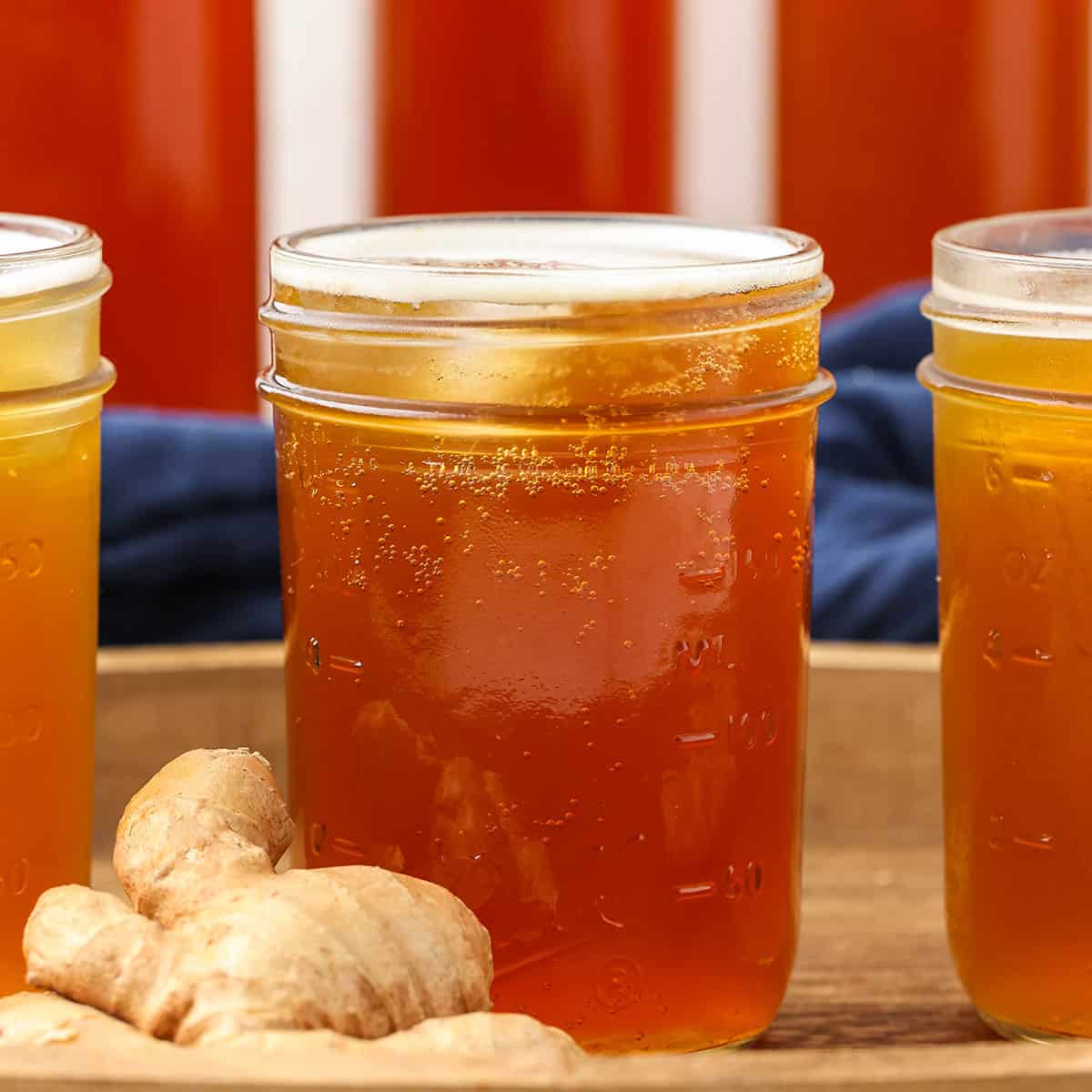
Want to save this post for later?
Flavored Kombucha
Ginger kombucha is one of the easiest flavors to make using a second ferment. Once you know how to make kombucha with a SCOBY, bottling it for a second fermentation gives it flavor and other herbal benefits.
There are many flavor options for the second fermentation of kombucha. Strawberry kombucha and hibiscus kombucha are both delicious flavors to try.
You can also get more creative and make dandelion kombucha or jun kombucha, which uses green tea and honey. However, ginger is a classic flavor that is even easier to make at home!
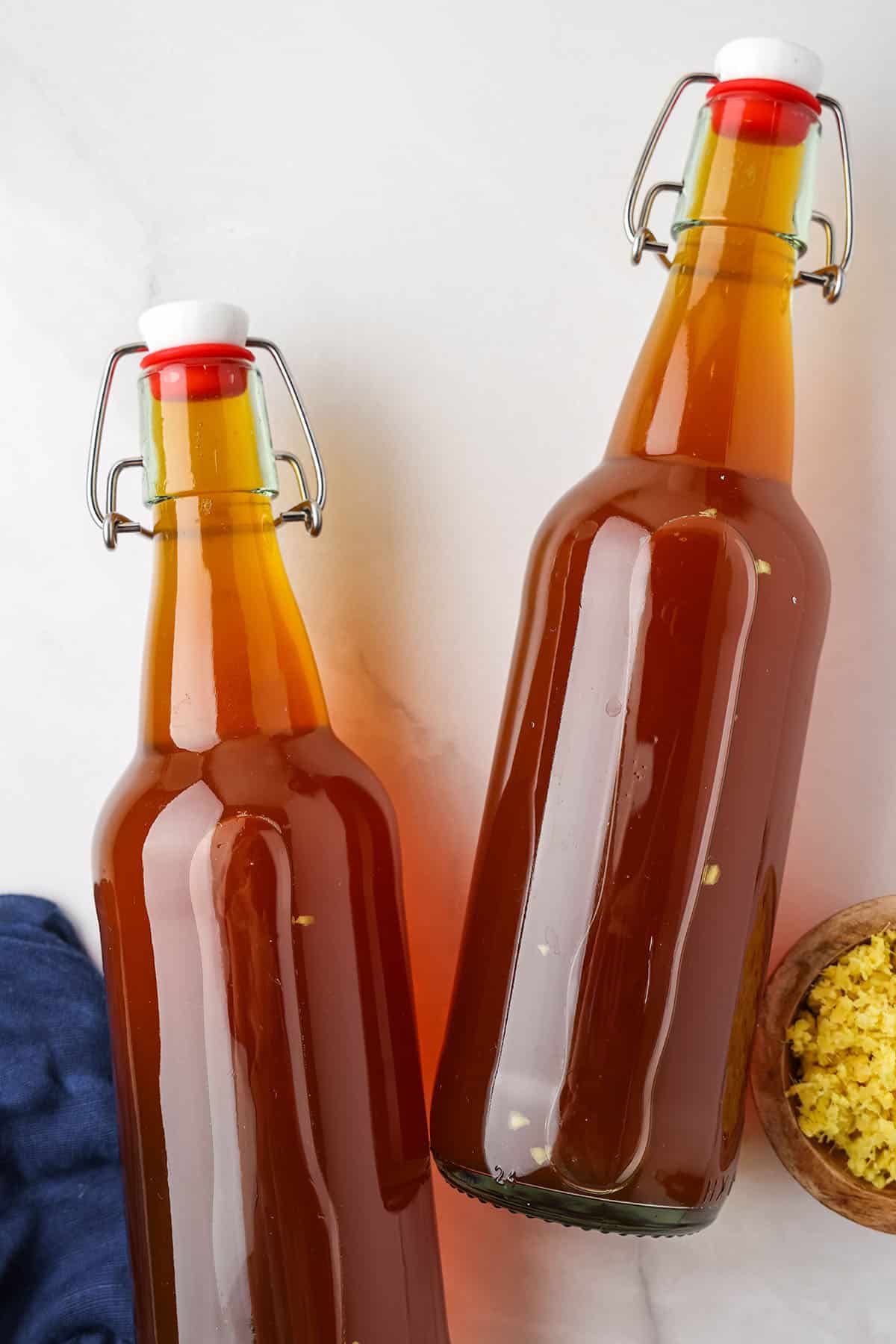
Ginger has many benefits, such as aiding digestion, soothing an upset stomach, and having anti-inflammatory properties. Plus, it makes a delicious tasting kombucha flavor.
Knowing how to second ferment kombucha is a good skill and an affordable way to keep the goodness of probiotics flowing in your diet. This ginger kombucha recipe is probably the easiest one you’ll ever make!
If you’re a newbie to homemade kombucha, this recipe is a great place to learn how to second ferment. It takes just a few simple ingredients and a few minutes to prepare.
Do your gut health, your taste buds, and your budget a favor, and make this ginger kombucha!
Ginger Kombucha Recipe
Before starting a second ferment to make ginger kombucha, you’ll need to have a batch of basic kombucha brewed and ready to use.
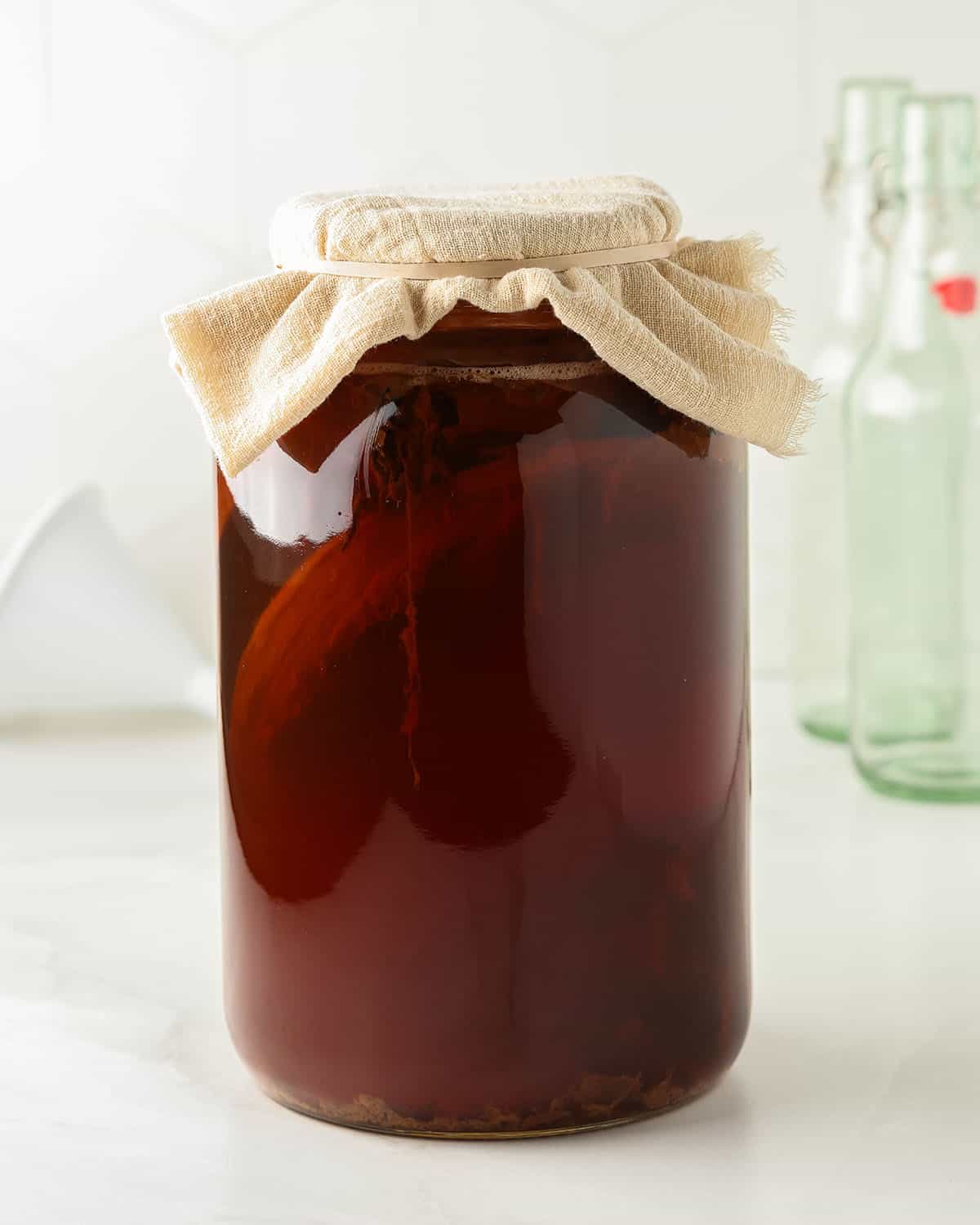
Once that is ready, you only need a couple of basic ingredients for the second ferment, as well as 8 flip-top bottles that are 16 ounces each. This is a quick and easy recipe that is fun to make!
Ingredients
Fresh ginger: Peel and finely mince the ginger small enough to fit into the bottle tops. I like to use a microplane to make it quicker and easier!
Sugar: I use organic cane sugar, or raw sugar can be a substitute.
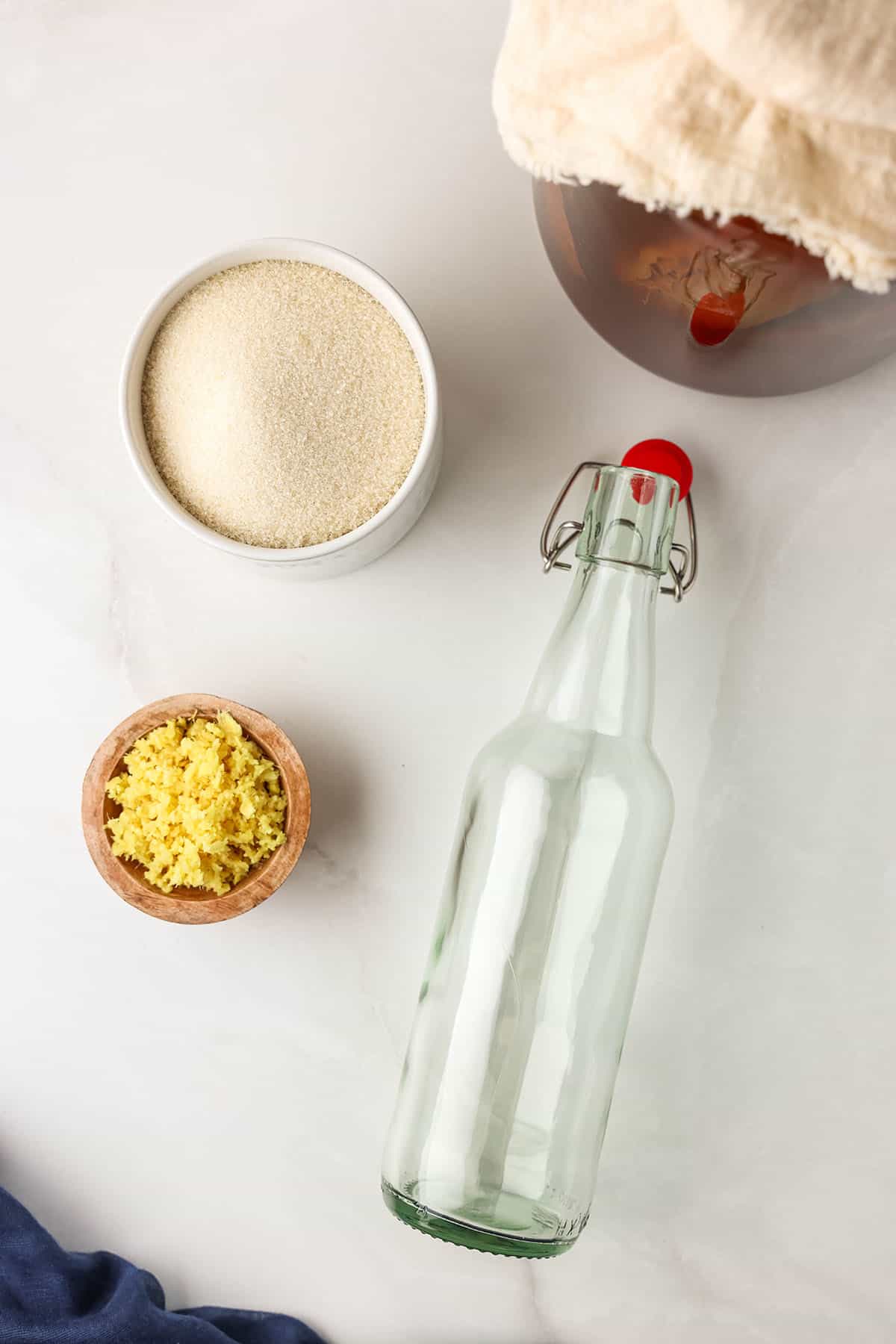
How to Make Ginger Kombucha
First, use a funnel to add two teaspoons of sugar to each bottle you plan to use during the second fermentation process. The kombucha should fill about 8 bottles if they are 16 ounces.
Then, add one teaspoon of minced ginger to each bottle.
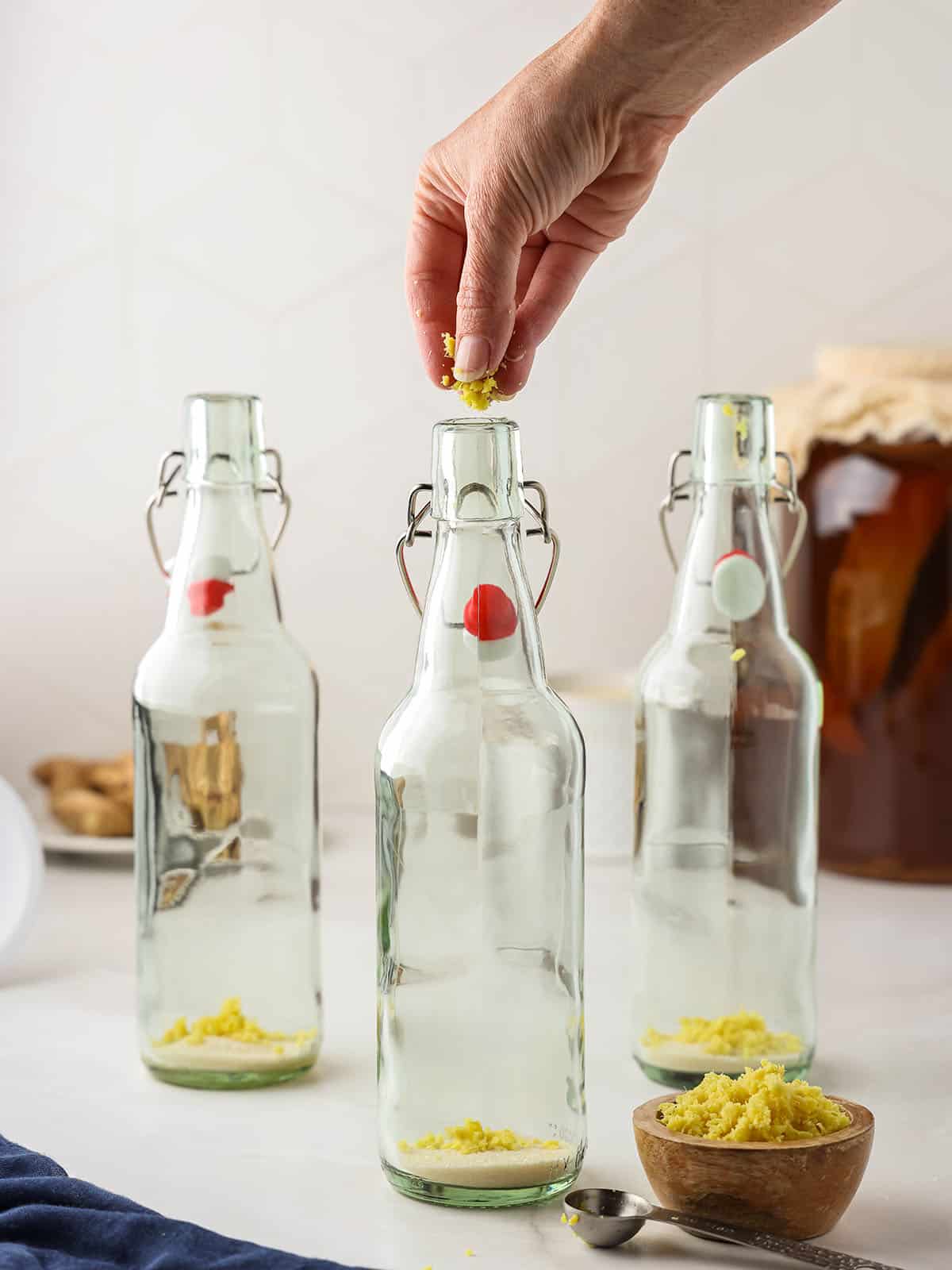
Gently swirl the pre-made fermented kombucha from the first fermentation process to evenly distribute the yeast before you pour it into the bottles.
Then, pour the kombucha into each bottle, leaving about 1-2 inches in the neck for headspace.
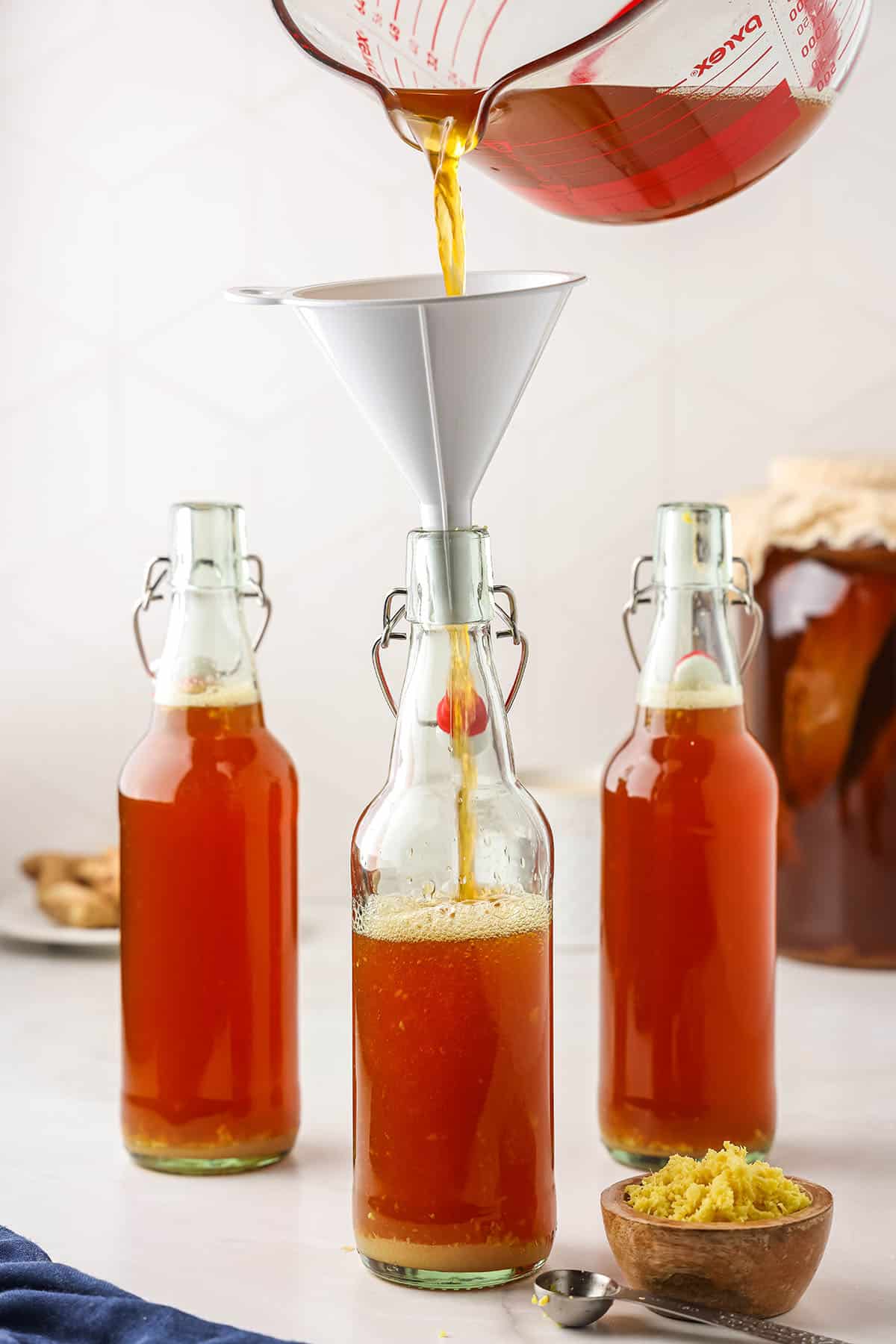
Now seal the bottles and shake them gently to mix the sugar until it dissolves into the liquid.
Place the bottles in a room out of direct sunlight where you will remember to check on them daily. A kitchen corner, pantry, or laundry room usually works well.
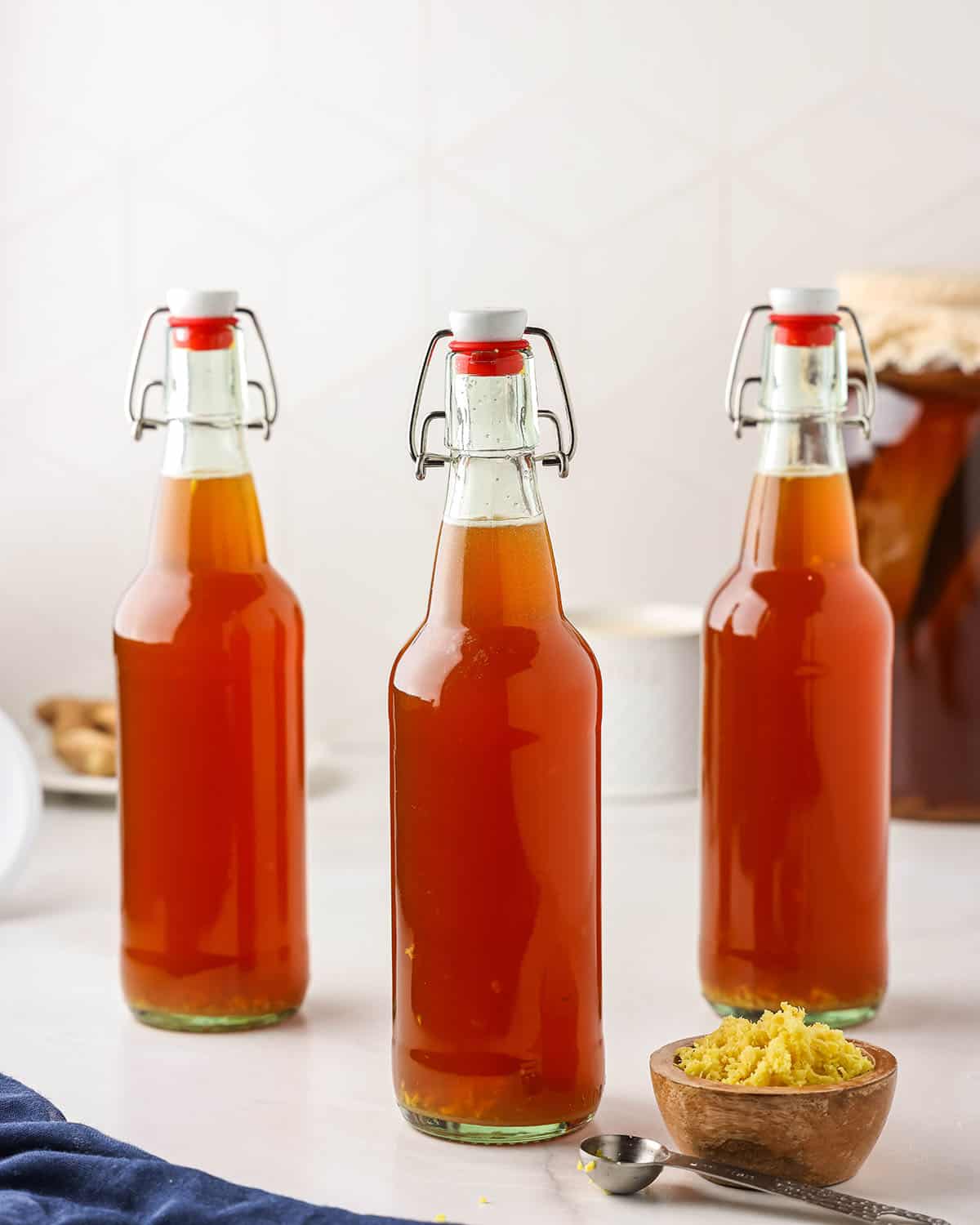
As the fermentation process occurs, you will notice little bubbles forming at the top, and the yeasts will float. Check the bottles and “burp” them at least once daily to release pressure.
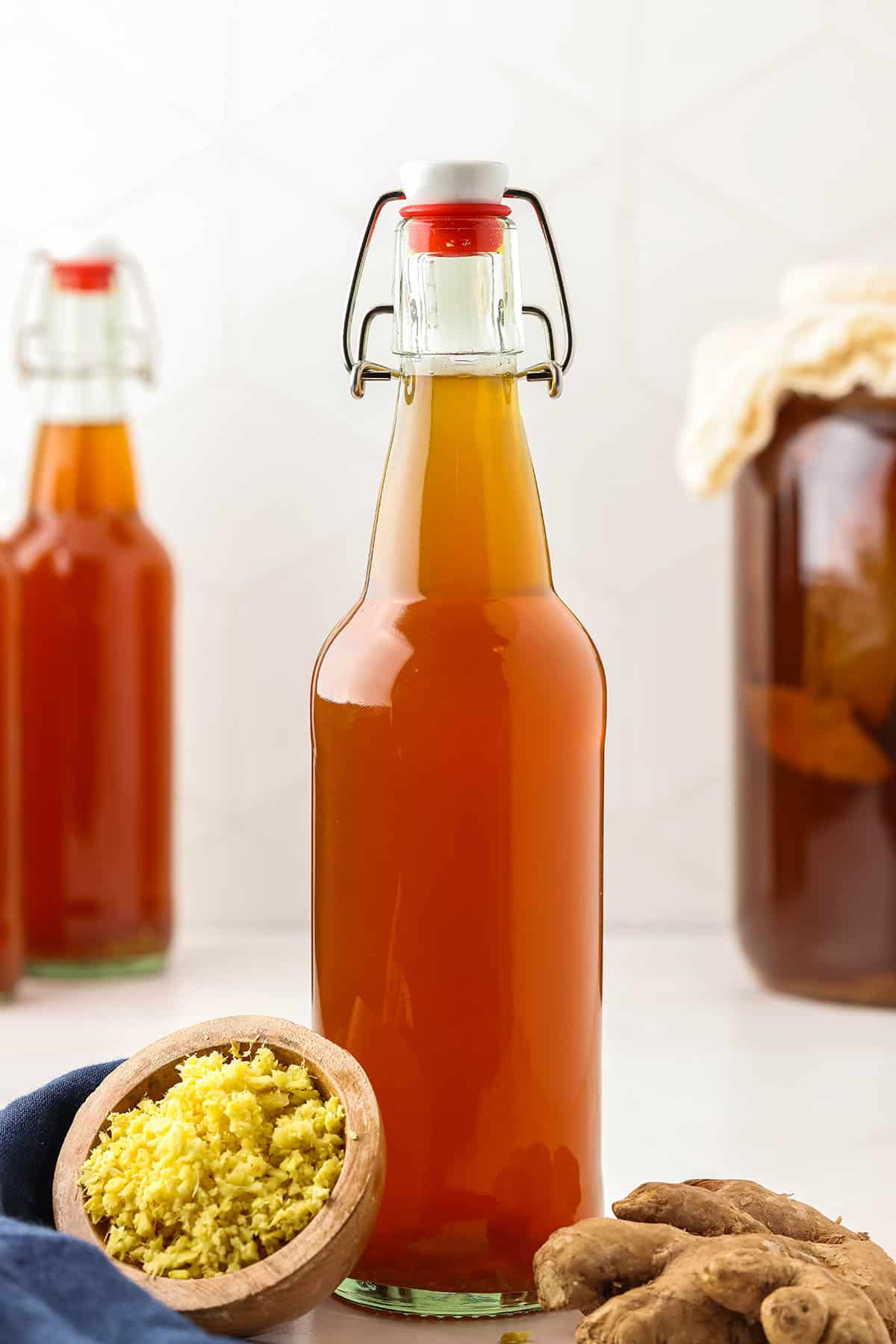
When you burp the bottles to release the pressure, check to see how quickly the bubbles race to the top. If there are only a few bubbles that are slow to make their way to the top, replace the lid and check the next day.
If the pressure release is loud when you open the bottle and bubbles race to the top, move that bottle to the refrigerator to slow fermentation and keep the ginger kombucha from exploding.
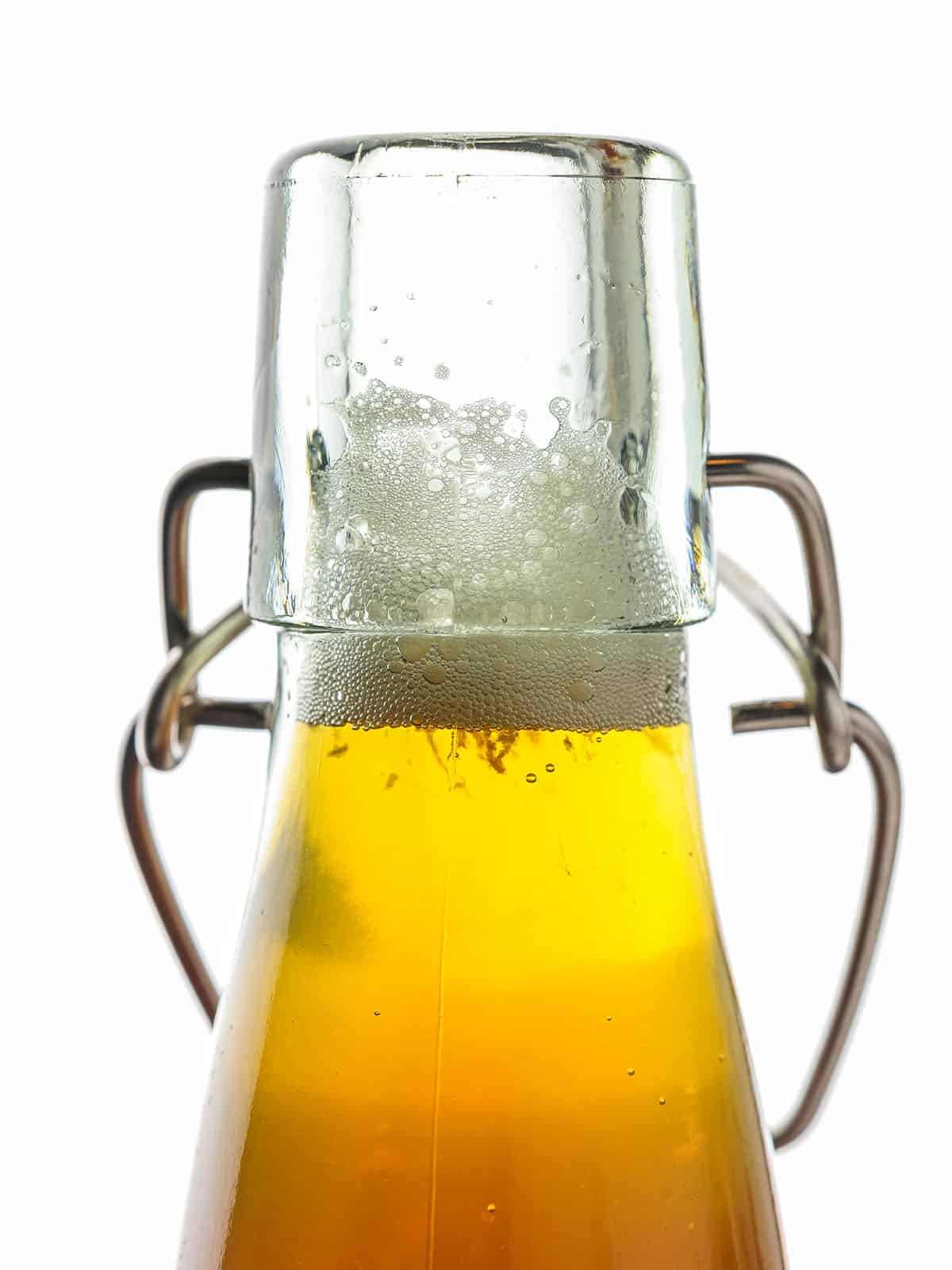
Depending on the ambient air temperature, this can take 2 to 14 days. In cooler weather, kombucha takes longer to ferment. In warmer weather, the process goes much faster.
Note: If you’re new to making kombucha, I recommend checking your bottles daily until you are familiar with the process and how long it takes with the temperature and season of your area.
A last optional step is to strain out the ginger pieces before serving, but it’s up to personal choice and how gingery you want it.
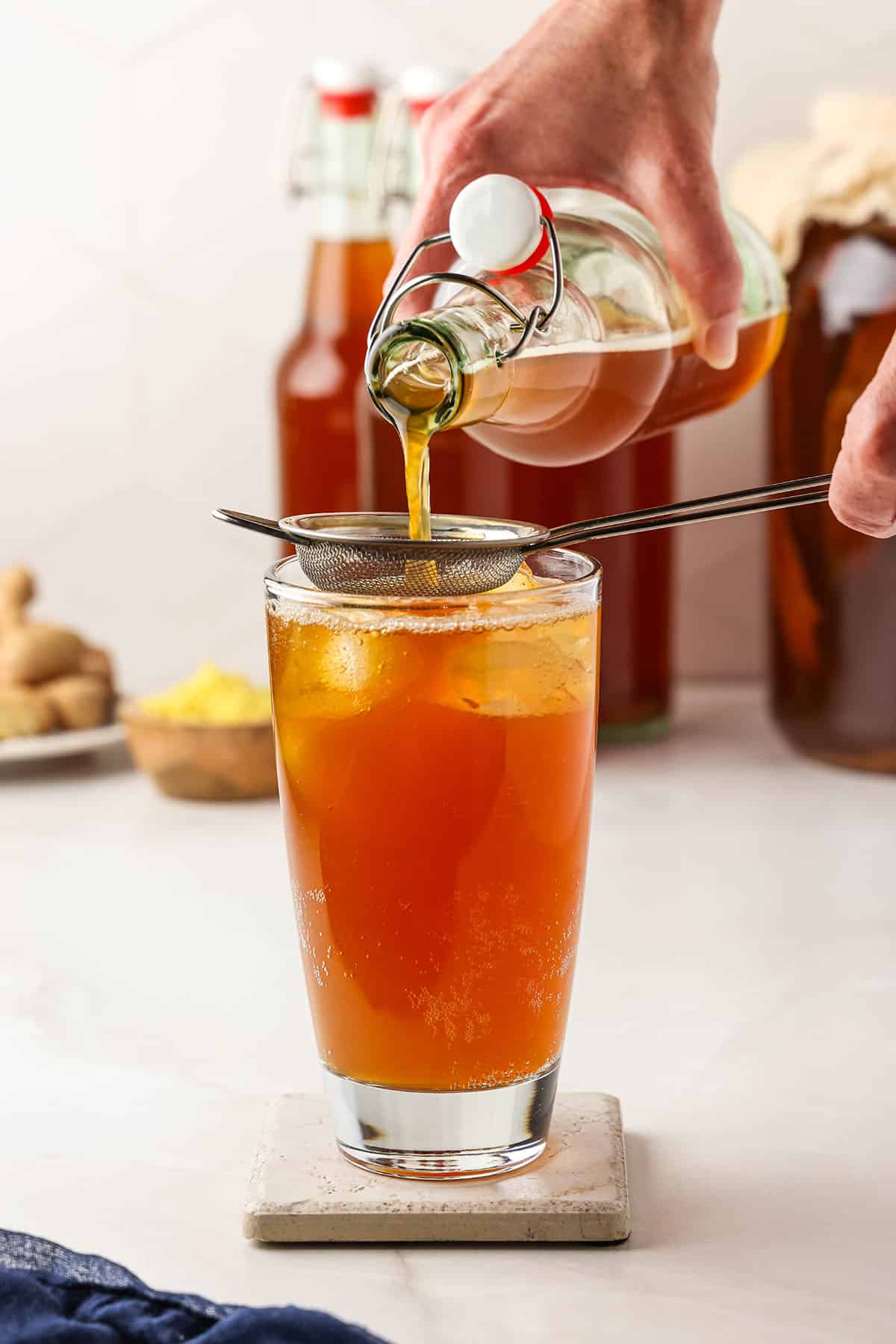
Once the ginger kombucha is ready to drink, enjoy this refreshing, chilled, probiotic-filled drink whenever the mood strikes you!

Best Kombucha Flavors
- Blueberry Kombucha
- Dandelion Kombucha
- Hibiscus Kombucha
- Lavender Kombucha
- Rose Kombucha
- Strawberry Kombucha
- Watermelon Kombucha
- Blackberry Kombucha
- Green Tea Kombucha
- Elderberry Kombucha
- Apple Ginger Kombucha
- Pumpkin Kombucha
- Cranberry Kombucha
- Cranberry Kombucha
Other Fermented Drinks
- Strawberry Water Kefir
- How to Make Water Kefir
- 12 Fermented Soda Recipes
- Pine Needle Soda
- Fermented Root Beer
- Strawberry Rhubarb Soda
- Yarrow, Rose, and Strawberry Soda
- Herbal Water Kefir Soda
Ginger Kombucha
Ingredients
- 16 teaspoons sugar
- 8 teaspoons fresh ginger peeled and finely minced
- 16 cups fermented kombucha
Instructions
- Using a funnel, add two teaspoons of sugar to each bottle that you plan to use during the second fermentation process.
- Add one teaspoon of minced ginger to each bottle.
- Gently swirl the fermented kombucha (from the first fermentation process) before you pour it into the bottles to distribute the yeast evenly. Then pour the kombucha into each bottle, leaving about 1-2 inches in the neck of the bottle for headspace.
- Seal the bottles and shake them gently to mix the sugar until it dissolves.
- Place the bottles in a room that is out of direct sunlight, and where you will remember to check on them daily.
- As the fermentation process occurs, you will notice little bubbles forming at the top and the yeasts will float. Check the bottles daily and “burp” them at least once daily to release pressure. If there is built up pressure and bubbles race to the top, then move the bottles to the refrigerator. Depending on the ambient air temperature, this can take anywhere from 2 to 14 days or so.
- Strain out the ginger pieces before serving if you prefer.
Notes
- When you burp the bottles to release the pressure, check to see how quickly the bubbles race to the top.
- If you only see a few bubbles and they are slow to make their way to the top, you can replace the lid and check the next day.
- If the pressure release is loud and bubbles race to the top, then you know it is time to move that bottle to refrigeration!
- In cooler weather, kombucha takes longer to ferment. In warmer weather, the process goes much faster.
- I recommend checking your bottles daily until you are familiar with the process and about how long it takes in the temperature in your area.
- Refrigeration slows the process, which will keep the kombucha from exploding under pressure.

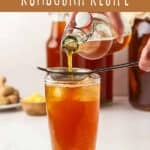
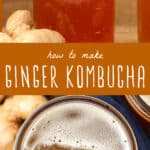
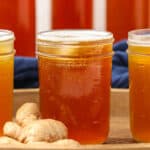

Is it the same process to flavor a water kefir with ginger?
Similar. I would follow my strawberry water kefir recipe and swap the berries for ginger.